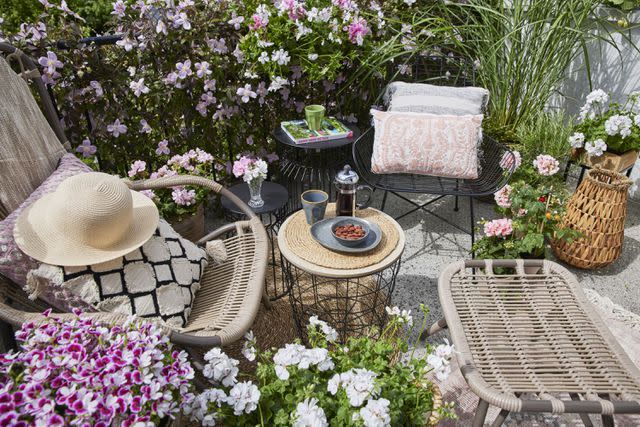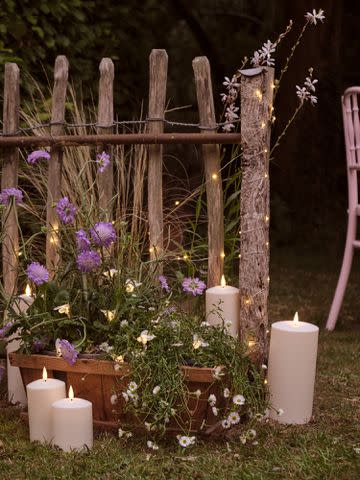Should You Try "Meadowscaping" Your Lawn and Yard This Season?
Landscaping experts explain why they love this trend

HornbyWhitefoot PR
Aesthetics and style trend have taken over our interiors, and we love that trends are spreading into our outdoor spaces, too. This year, as organic decor and biophilic design continue to dominate our home decor feeds, a similar gardening trend is growing—literally.
'Meadowscaping' is the act of using wildflowers, grasses, and other native plants to replace a neatly manicured lawn that is associated with traditional landscaping. Meadowscaping creates a wild, overgrown, prairie-inspired feel and is taking yards by storm. By incorporating many plants and flowers through meadowscaping, pollinators are benefitted and biodiversity is sustained far more than with grass alone.
Read on to find out the latest look we love, which one expert called “a celebration of biodiversity."
Nikhil Arora is the co-founder of organic plant product brand Back to the Roots.
Katie Tamony is the CMO and trendspotter for the gardening brand Monrovia.
Lawns Inspired by Wildflower Fields
With everyone talking about “bringing the outdoors in” and leaning into all things cottagecore, turning our outsides into actual meadows also makes perfect sense. According to Nikhil Arora of Back to the Roots, that’s exactly what’s happening.
"Meadowscaping is creating a garden that mimics a wildflower meadow or prairie by planting a variety of native plants that support local wildlife,” he says. “It's really a celebration of biodiversity."

HornbyWhitefoot PR
Perfect Lawns Are On Their Way Out
Katie Tamony from Monrovia says meadowscaping is a natural step for people who are shying away from overly landscaped lawns. If you love a more wild, natural look in your garden, the "meadowscaping" idea may be for you, Tamony says.
"As homeowners are exploring ways to ditch the perfect green lawn and an overreliance on chemicals, meadowscaping is taking hold,” she explains. “It’s also awakening interest in planting natives.”

Meadowscaping Improves Biodiversity
There’s no denying that a "meadowscaped" lawn can be truly beautiful, but there are other major benefits to this aesthetic. Along with providing ecological benefits, Arora says it also improves biodiversity. This trend provides habitat for pollinators, while also reducing maintenance and water use compared to traditional lawn care, Arora explains.
“It's beautiful, saves water, and is great for our pollinator pals," she says.
Best Suited for Spaces with Full Sun
If there’s a downside to meadowscaping, it’s that every lawn might not work with this approach to planting. Arora says if you’re going to do it, you need the right conditions. As many flowers need full sun, meadowscaping is best suited for larger areas with full sun exposure.
If you can check that item off your list, then it’s just a matter of what kind of plants you should include.
“A great meadowscape needs a mix of native grasses, wildflowers, and other perennials that can thrive in the local climate and soil conditions,” Arora says. “It should also include a mix of plant heights and bloom times to provide year-round interest and support for different wildlife."

Meadowscaping Contributes to Your Local Ecosystem
As Tamony points out, meadowscaping is about so much more than creating a beautiful yard—it’s also about contributing to nature. When done properly, it doesn't just improve your outdoor space. It can also majorly benefit your land's biodiversity, too.
“Each garden is part of a larger ecosystem, and we all want to do our part to support pollinators and birds,” she says. “As homeowners are becoming more aware and concerned about planting for their climate, there’s an interest in learning more from nature.”
Meadowscaping, explains Tamony, is a natural way to reflect that interest in our landscape designs. A beautifully meadowscaped lawn should look effortless and carefree—but never wild and overgrown.
“It can become a tangled, messy, and overgrown scene,” she says, noting that maintaining a sense of structure is still important. This can easily be done with some pre-planting planning.
“We suggest gardeners still think about some plants that stay compact to balance out the ones that can really get wild,” Tamony says.

Lights4fun.co.uk | ©Lights4fun Ltd. Image Shot by Oliver Perrott
If you love the idea of a meadowscape but can’t imagine turning your entire yard over to this look, Tamony suggests starting small. Choose a smaller border area, near a patio or a pathway, to see how you live with the meadowscape idea—and who knows, you may love the wild and free look that you may ditch the green lawn for a wildflower paradise instead.
Read Next:Designing a Dreamy Wildflower Garden You Can Maintain

